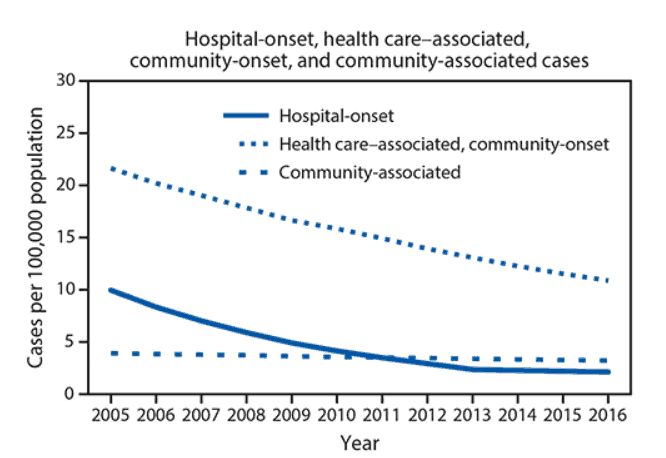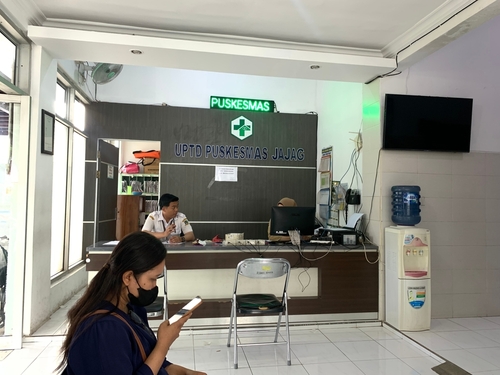March 22, 2019

Recent trends in MRSA infections in the US. In 2017, there were an estimated 119,247 Staphylococcus aureus bloodstream infections and 19,832 associated deaths in the US, researchers from the US Centers for Disease Control and Prevention reported following a review of two nationally representative disease surveillance databases. Between 2005 and 2012, the rates of hospital-onset methicillin-resistant S. aureus (MRSA) bloodstream infections decreased by 17.1 percent annually, but this decline slowed between 2013 and 2016. Between 2005 and 2016, community-onset MRSA rates declined 6.9 percent annually, primarily due to reductions in healthcare–associated infections. Between 2012 and 2017, rates of hospital-onset methicillin-susceptible S. aureus (MSSA) infections did not change while community-onset MSSA infections increased 3.9 percent each year. [MMWR]
Sinks in patient rooms harbor Klebsiella pneumoniae carbapenemase resistance genes. Researchers collected swab samples from 46 sinks in patient rooms and bathrooms in a 26-bed intensive care unit in Wisconsin. Samples underwent direct polymerase chain reaction (PCR) testing and culturing to detect the presence of blaKPC, a gene that confers resistance to carbapenem antibiotics in Klebsiella pneumoniae. The blaKPC gene was detected in 54.3 percent of sink drain specimens tested by PCR. The gene was more likely to be present in sinks located near toilets in patient bathrooms compared to those near the entry door (87.0 versus 21.7 percent). [AJIC, APIC Press Release,]
Pharmacist review of patients labelled with penicillin allergy reduced use of restricted antibiotics. Over a five-month period, a team of clinicians led by an antimicrobial stewardship pharmacist reviewed medical records at a tertiary care facility in Australia and identified 106 patients who had a documented penicillin allergy and were taking an antibiotic. Researchers assessed each patient’s medical history and determined whether a patient could undergo a direct oral re-challenge or a skin test for penicillin tolerance. Overall, 37.7 percent of patients could safely consume penicillin and had their allergies de-labeled. Following this intervention, prescribing of restricted antibiotics, defined as third- or fourth-generation cephalosporins, fluoroquinolones, glycopeptides, carbapenems, piperacillin/tazobactam, lincosamides, linezolid, and daptomycin, was reduced from 42.5 percent to 7.9 percent. [JAC]
Shorter TB treatment regimen noninferior to longer treatment in clinical trial and reduces resistance acquisition. In a phase 3 noninferiority trial, 424 patients with rifampin-resistant tuberculosis (TB) that was susceptible to fluoroquinolones and aminoglycosides were randomly assigned to receive either a 9 to 11-month or 20-month regimen of high-dose moxifloxacin. Favorable status, defined by cultures negative for Mycobacterium tuberculosis at 132 weeks and at a previous occasion with no positive culture or previous unfavorable outcome, was reported for 79.8 percent of patients who received the 20-month regimen group and for 78.8 percent of those in the 9 to 11-month regimen group. The incidence of adverse events was similar among the two groups. Overall, acquisition of resistance to fluoroquinolones or aminoglycosides occurred in 3.3 percent of patients on the longer regimen, in contrast to 2.3 percent of patients on the shorter regimen. [NEJM]
Delays in plague diagnosis in Colorado dog leads to over 100 potential human exposures. In December 2017, a dog ultimately diagnosed with pneumonic plague (Yersinia pestis) was brought to a veterinary teaching hospital in northern Colorado. Upon admission, plague was considered unlikely due to the season, lack of typical symptoms, and rarity of such infections among dogs, and isolation precautions were not taken. Delays in plague diagnosis led to 116 potential human exposures and 46 potential animal exposures over two days. There were no cases of Y. pestis infection in potentially exposed humans or animals, according to the US Centers for Disease Control and Prevention. [EID]
Widespread use of high-dose ceftriaxone therapy for uncomplicated gonorrhea in China. Between January 2013 and December 2017, researchers enrolled 1,686 patients infected with Neisseria gonorrhoeae from seven hospitals across five provinces in China into a surveillance program to assess antibiotic prescription patterns and therapeutic efficacy in the treatment of uncomplicated gonorrhea. Of the 1,333 isolates that underwent antimicrobial susceptibility testing, 9.8 percent demonstrated decreased susceptibility to ceftriaxone. At the initial visit, 7.1 percent of enrolled patients received oral cefixime, 8.9 percent received other extended-spectrum cephalosporin, and 83.1 percent received injectable ceftriaxone most at doses higher than 1,000 milligrams. Following antibiotic therapy, all patients who returned for a follow-up visit were cured of infection. While there was no ceftriaxone failure treatment among study participants, the impact of commonly prescribing high-dose ceftriaxone needs further analysis, researchers noted. [CID]
Preventable conditions a leading cause of death among children in India, China, Brazil, and Mexico. Researchers analyzed cause-specific mortality data for 244,401 children aged 5–14 years from India, China, Brazil, and Mexico, where approximately 40 percent of deaths in this age group occur each year. India was the only country where communicable diseases accounted for nearly half of all deaths, 51 percent among girls and 42 percent among boys. In 2016, communicable disease mortality rates were 17–19 times greater in India than in China and 7–12 times greater than in Brazil or Mexico, depending on sex. In China, injuries, especially those due to drowning, were a leading cause of death among boys and girls. In Brazil and Mexico, non-communicable diseases accounted for the highest proportion of deaths. [The Lancet]
Expanding range of arbovirus-carrying mosquito species in the US and Europe. Using statistical mapping techniques that incorporated global climate change models and human urban growth rates and projections, researchers modeled the past and future spread of the Aedes aegypti and Aedes albopictus, two mosquito species that carry dengue, yellow fever, and Zika virus, among other pathogens. In the US and Europe, the spread of Ae. Albopictus was likely due to short-range importation between adjacent districts whereas Ae. aegypti was more frequently imported over longer distances. Ae. albopictus spread in the US has slowed since 1995 to an estimated 60 km per year while in Europe, rate of spread has increased from 100 km per year to 150 km per year in the past 5 years. Both mosquito species will expand their geographical ranges worldwide to 159 countries by 2080, researchers predict. [Nature]
Photo: Hospital-onset, healthcare-associated, community-onset, and community-associated MRSA bloodstream infection rates from population based surveillance at six US Emerging Infections Program sites, 2005-2016. Source: CDC MMWR.











